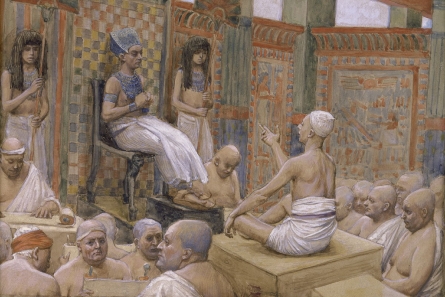In the beginning…
Dear Sr. Veronica,
Thanksgiving is right around the corner. I don’t know what kind of big hooplah you sisters put on for Thanksgiving, but around our house it gets pretty crazy. We do a big feast at my wife’s parents with her 3 brothers and little sister, their spouses, Grandpa (who’s 98 this year) and 16 nieces and nephews. To say that it gets a little bit chaotic is an understatement.
What makes it all work is the fact that we’ve been doing it for years. My wife coordinates who brings what dishes. The menfolk know exactly what needs to be done to set up the extra tables and chairs. And I wash the dishes. (Nobody wants me cooking anything.)
The plan makes it work, because everyone knows the answers to “who’s doing what?”, “when does it need to be done?”, and “where does that thing go?”.
The more people involved in anything, the more you need a plan. The old cliché is “Failing to plan is planning to fail.” For this capital campaign, we’re going to need to coordinate the activities of many people over the course of many years. Raising the kind of money that you need is not a trivial task.
The capital campaign will be broadly broken into two distinct phases: the quiet phase and the public phase. The quiet phase happens before you tell everyone and launch the public phase of the campaign. The public phase tries to stir up attention and excitement to bring the campaign to a successful conclusion. This will make sense once you see it all laid out.
The sound of silence.
The activities of the quiet phase include the following:
- Develop your case for support. You’re already working on that, I hope. It was your homework from my last letter. The written case for support will be used as the basis for any additional marketing materials (called collateral) like videos, website, pamphlets, posters, folders, etc. that will be used for the campaign.
- Find your big donors. You’re going to identify and talk to donors who love your order and have the ability to make big gifts. The campaign term for this process is a “feasibility study.” This is one part research and one part fundraising. If your research doesn’t suggest that you have enough potential donors who can make big gifts, you might decide that your building plan will need to change to match the resources that will be available.
- Recruit fundraising volunteers. The other big fruit of the feasibility study is securing the volunteer leadership that you need to make the campaign a success. You don’t just want people who can make big gifts, you want to find ones who are willing to reach out to their network of friends and connections for large gifts of similar size.
- Create your solicitation plan. During the quiet phase, you’ll build your plan of solicitation to make sure that every potential donor gets asked by someone who has a good relationship with them. We’ll talk more about this later because it is very important. A big part of this plan is making sure that you have good accountability structures to manage the volunteers and follow-up on gifts that are pledged to the campaign.
- Finalize your construction plans. The conversations that you will have with potential donors will give you valuable information on the amount of money that you think you’ll be able to raise. Depending on the reaction that you get from your potential donors, you may actually have to change your plans. That is ok.
- Secure principle gifts. You might not realize this, but the majority of the fundraising will take place during the quiet phase. I’ll get into this more later, but consider that you’ll probably be raising more that half of this money from as few as 30 donors. These people need to be on board before you announce the campaign to the public.
If the quiet phase of the campaign goes well, it is likely that the rest of the campaign will go well. You’ll have a solid group of volunteer leaders, a well thought out action plan, and a powerful case for support to get people excited about giving to the campaign.
The Big Bang!
In the beginning, when God created everything out of nothing by uttering His perfect Word, I’d like to think it sounded a lot like a shout of triumph. He thought everything out in advance (and I do mean everything), but it only came into being when He announced it. All creation still reverberates with the power of His Word.
This is the kind of big splash that you’d like to make when you begin the public phase of your campaign. Aim high. After spending enough time in the quiet phase to get everything into place, you will announce the campaign with lots of fanfare to get people excited about it.
The activities of the public phase include the following:
- Kick off the campaign. You’ll start the campaign with a big public announcement of the campaign’s existence and purpose, the campaign’s goal, and the campaign’s leadership. We have lots of different options of how to do this. We should probably consider doing kickoff event for the leadership volunteers and primary donor prospects. We can launch the website using email and direct mail pieces, as well as getting the word out on social media. We should be able to get some coverage in the Catholic press, TV, and radio, but I think that it’s doubtful to get any press in the major news outlets. One big piece of information you’ll include in the announcements is how much money has already been committed during the quiet phase. People like to jump on a train that’s already moving, so we should plan to have least 50% of our goal already committed.
- Work the solicitation plan. Your quiet phase planning will now pay off as you work with your volunteer leaders to solicit all of the donors that you have on your prospect list. A big part of this process is accountability and record keeping, because you’ll want to keep an accurate tally of which prospects have been solicited and how much have they committed to give.
- Begin “thank you’s” and follow up. Nothing makes me sadder than a gift that never materializes. If we don’t do a good job of saying thank you and following up with donors on their pledges, that is exactly what will happen. Not necessarily out of malice and hard feelings… people forget, get distracted, put writing a check on a never-ending list of things to do that never get done. By promptly thanking them for their gifts and following up on their pledges, we are making it easy for them to do what they have already agreed to do.
- If necessary, pull out the contingency plan. I hate to mention this possibility, but prudence dictates that we consider what we do if we are unable to raise the full amount of the campaign goal. Remember what Jesus said about the man who tried to build a tower but failed to consider the cost. (Luke 14:28) The contingency plan might be the choice to use other financing options to fill the gap, scaling the project down to matched the funds, or launching an urgent followup appeal to stir up additional giving. We will want to know what options we have on the table in advance.
- Celebrate success! When the campaign has met the goal, we need to have a celebration that honors the volunteers and donors who have given to make it a success. This can be done during an event, but should also be communicated to your community of donors through a nice direct mail piece announcing the success of the campaign. Failing to do this or not doing this well is robbing your donors (especially your hardworking volunteer fundraisers) of the well deserved opportunity to rejoice that your labors have come to an end.
- Steward your donors. This might be the most neglected parts of fundraising, but one of the most important. Once the gifts have been spent and the new monastery has been build, you need to share the news and say thank you again. They will give because they believe in the importance of building your new monastery. Seeing their vision become a reality will give them great satisfaction. You don’t even have to wait until it’s completed to begin stewarding them. Send them pictures and videos of the progress being made on the monastery. Everyone I know loves process videos, especially if they use time-lapse photography. Not only will this make them happy, it will encourage them to pay their pledges if their gift was in the form of a multi-year commitment. You should also consider how to include your supporters in the grand opening of the new monastery, which is the real end of the capital campaign.
By the end of the public phase of the campaign, the new monastery will be finished and the bills will be paid. Praise the Lord.
One bite at a time.
If you think this seems like a lot of work, you’re right. It’s a lot of work to raise millions of dollars and build a monastery for 50 sisters that should last for the next 200 years. The only way to do it is the way that you’d eat an elephant. You’ve got to focus on the small bite you have on your fork.
We’ll work our way through this elephant, and by the end, it will taste a lot like Thanksgiving.
Blessings,
The Almoner
P. S. I’d never actually eat an elephant. How about a buffalo?
Today’s post is the third letter in the second volume of the “Letters from the Almoner” series. These fictional letters will open a window into conversations between a professional fundraiser and a religious sister who running a capital campaign to raise money to build a new monastery.
Would you like to learn more about raising money for Church and Ministry? Check out Letters From The Almoner, now available on Amazon.com.
Image courtesy of Pixabay.com, via Creative Commons License, no rights reserved.








